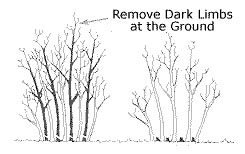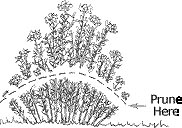Our crews at Nature’s Perspective have begun pruning small trees and shrubs at our maintenance properties. The record rains and cool temperatures, interspersed with a few hot days, has made for lots of spectacular growth. We like to wait until most plants have finished flowering and after the new growth has started to harden up. This makes for the most efficient and effective pruning. We try to prune using the plant’s natural habit as a guide so that when we are done, the plants look tidy, but not sheared nor sculpted. Here is some information on the how and why of pruning… if in doubt give us a call.
Proper pruning enhances the beauty of any landscape tree and shrub, while improper pruning can ruin or greatly reduce its landscape value.
The old saying is to “prune when the knife is sharp.” That means that the “best time” to prune is almost any time you and the proper tools are ready. This can be true, but there are some “better” times to prune. The only time you should not do a hard prune is late summer when rapid growth may be encouraged but will not harden off before winter. Dormant pruning is a term for pruning done in late winter or early spring before new growth begins. It is a time when the branch structure is visible (since leaves are off) and corrective pruning can be done easily.
Spring-flowering plants typically bloom on last season’s growth, or on old wood, and should be pruned soon after they bloom. This will allow for vigorous summertime growth and result in flower buds the following spring. Examples of this type of plant are Forsythia, Lilac and Viburnum.
Some shrubs that bloom after June usually do so from buds which are formed on shoots that grow the same spring, or on new wood. These shrubs can be pruned in fall or winter to promote vigorous shoot growth in the spring. Examples of this type of plant are Hydrangea, Summer Spirea and Rose.
It is important to know which type of shrub you have and which pruning time is best for your shrub.
Types of Pruning
Besides trimming to tidy the appearance of the plant and to control growth, there are two major types of pruning: gradual or renewal pruning and rejuvenation pruning.

In gradual renewal pruning, a few of the tallest or oldest branches are removed at or slightly above ground level annually. Generally one third of the plant can be should be removed each year, creating a fully renewed plant in three years. Removing these oldest largest stems allows light into the interior of the plant which stimulates new vigorous shoots to develop. Some thinning may be necessary each year to shorten long branches or to maintain a symmetrical shape. This pruning will help increase flowering and fruiting production, even on the first year of the pruning cycle.
Another type of pruning is rejuvenation pruning. This is the complete cutting of all stems to slightly above ground level (6 to 12 inches). This is a more drastic option, but is ideal if your shrub has become too large, leggy or has too many stems. Do not do this type of pruning during the growing season. A flush of new growth will emerge in spring. Similar to renewal pruning, some thinning may be necessary each year to shorten long branches or to maintain a symmetrical shape.
Use high quality tools designed for pruning, such as bypass pruners, pruning saws and loppers. Wear thick gloves. Sharp, clean tools are essential- and keeping a sharp eye on your work assures safety.

